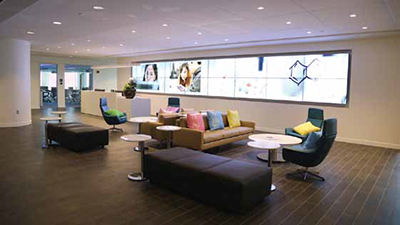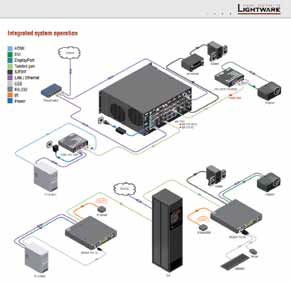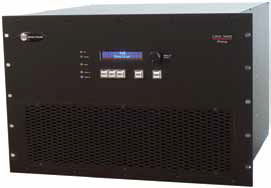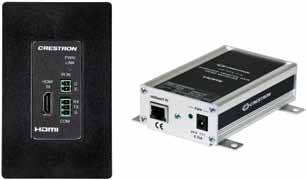HDBaseT connectivity took a big step forward with the announcement at the Integrated Systems Europe (ISE) 2014 show in Amsterdam of a new generation of chipsets compliant with the version 2.0 specification.
A 2x8 videowall at Vertex Pharmaceuticals’ new corporate headquarters in Cambridge, MA, comprised of 55-inch Primeview Ultra Narrow Bezel monitors, which are HDBaseT-enabled. The videowall is supported by a Spyder X20 0808 image processor from Vista Systems. Vertex used ACT Associates as its AV consultant for the new campus. At ISE, HDBaseT Alliance founder Valens introduced its Colligo family of chips, which support native USB 2.0 and HD audio, enable the transmission of 4K video over Cat-5/6 cables up to 100m in length, and add single- and multi-mode fiber transport over distances up to 10km.
With dozens of manufacturers introducing HDBaseT-compliant products at ISE, the technology is about as close to a standard as it can be. According to Michael DiBella, Atlona’s marketing and communications manager, “HDBaseT is very quickly becoming the standard for distributing content. Atlona was one of the earliest adopters of the technology, giving us an incredible competitive advantage. Now nearly every manufacturer realizes that in order to be competitive, they have to design their products using HDBaseT Alliance specifications.”
“If you go to the HDBaseT Alliance website and look at the members, it’s Sony, LG, Epson, Panasonic. All these guys didn’t join this group if they didn’t plan on doing something,” said Dave Silberstein, director of channel development for Crestron.
Although those members are big players in consumer electronics, HDBaseT is proliferating more in commercial products. There is a cost associated with HDBaseT, including a connector and chip, which becomes prohibitive at the low-end of the retail price scale. “However, if you’re making a professional grade projector or a professional grade flat panel to go into the pro AV market, it’s worth it to spend the money,” said Silberstein.
Valens was hopeful that manufacturers of Blu-ray Disc players, televisions, and other consumer products would implement HDBaseT, added Ali Haghjoo, CEO of Hall Research. “They’re having their success on the display side and there are a number of projectors, but Blu-ray players are so price sensitive. Their chip starts at pretty much $30, just for one side—that’s the entire cost of a player!”
Even so, from both a residential and commercial standpoint, HDBaseT’s market penetration is significant, said DiBello. “Taking advantage of HDBaseT 5 Play is a no-brainer for every integrator and system designer. In my opinion, a year from now no product will be spec’d into any new installation if it is not HDBaseT-compliant.”
Apantac’s bread and butter is in the broadcast industry, reported company president Thomas Tang, where the company’s HDBaseT products are used as a transport, similarly to SDI, rather than as an HDMI extender. “Before, there was certain unpredictability in the traditional HDMI extenders; HDBaseT has proven to be more stable,” he said.
Tang does have one concern, though. “I foresee the market being flooded with inexpensive stuff that will actually hurt the HDBaseT name.”
When HDMI extenders hit the market, he said, “Everybody from around the world made this product and drove the price down, and the quality went down. Then HDBaseT came out and was proven to be reliable. Now HDBaseT prices are starting to drop.”
Board design—signal routing and termination— is also critical, said Haghjoo, since such high-speed signals are involved. “The transmitter and receiver are extremely power hungry, and they get very, very hot. So if you don’t do proper thermal management on your board the product is not going to live long. In that sense, not every HDBaseT device is created equal.”
But HDBaseT certainly has advantages over HDMI, said DiBella, not least its ability to transport over greater distances. “HDMI cannot be used for runs longer than 30 feet without compromising the content’s integrity. HDMI is great for local runs, but larger installations require sending content over standard twisted pair. That’s where HDBaseT comes in.”
One point of contention with HDBaseT is the implementation of its power-over-ethernet (PoE) capabilities by certain manufacturers, as noted by Haghjoo. “Not all HDBaseT products are following the Alliance recommendations. A lot of people are putting in random power; for example, some people are putting in 12 volts, some 28 volts, some 48 volts. The way I typically define the PoE standard is that the two ends do a low-voltage handshake, which means that you don’t have any high voltage just sitting there in your cable. That offers another degree of protection.”

With dozens of manufacturers introducing HDBaseT-compliant products at ISE, the technology is about as close to a standard as it can be. “It’s really dangerous to have that power running on category cable if you don’t put in the proper safety,” agreed Tang. But using HDBaseT’s PoE capability to remotely power a display, for example, may also expose its Achilles heel. “From a practical point of view, when you troubleshoot, it’s much harder to try to trace that cable back to the transmitter to figure out if it’s a power problem. You’re going to have to have local power or you’re never going to be able to boot up the monitor to see if it’s working, until all the extenders are in place.”
Firmware compatibility is also an issue, said Tang. “It’s stable as long as you use the same firmware, but then, to grab products off the shelf from just anybody, you run a risk of things not being compatible. Video will always pass; it would be RS-232, ethernet, and USB that would be affected via the firmware.”
Of course, HDBaseT is not the only game in town. “DisplayPort has its own advantages and disadvantages,” said Haghjoo. “To do DisplayPort you have to bridge to HDMI. A lot of Apple products have a Mini DisplayPort, or a Thunderbolt, now. You have to use an adapter to convert to HDMI, and then, you can go through HDBaseT. There are bridge chips that can do that, too.”
HDBaseT also has a blind spot regarding certain display resolutions, he added. “HDMI, currently, goes up to 1080p at 60, and then there’s a gap. The next resolution is 4K by 2K at 30 frames per second. But a lot of military and medical applications like the intermediate resolutions: 2560x1440, or 2560x1600. So HDBaseT is not capable of handling those.”
Despite its idiosyncrasies, “I don’t want to say it’s going to be the standard, I want to say it is the standard,” said Silberstein. “The big three switching manufacturers all use it, so it must be the standard.”
Steve Harvey (sharvey.prosound@gmail.com) has been west coast editor for Pro Sound News since 2000 and also contributes to TVTechnology, Pro Audio Review, and other NewBay titles. He has over 30 years of hands-on experience with a wide range of audio production technologies.
Q&A With Micha Risling, Valens Vice President Marketing & Business Development and Marketing Committee Chair, the HDBaseT Alliance
SCN: At the recent CES, HDBaseT 2.0 was being promoted as a solution for residential use, especially for 4K, but it also has pro AV applications. Are there enough HDBaseT-capable pro AV products on the market yet for it to be viable in that market?
Mischa Risling: Absolutely, and in fact when Valens introduced the HDBaseT technology in June 2010 and formed the HDBaseT Alliance with LG, Samsung, and Sony Pictures, the first priority was to raise awareness of the HDBaseT technology within the pro AV market and achieve widespread adoption within those communities. While that work will always be ongoing, we have made significant progress over the past three-plus years.
According to a September 2013 report from Futuresource Consulting, a U.K.-based research and consulting firm, the number of HDBaseT ports deployed in the global professional AV market will exceed 21 million by 2016. That number represents a 50 percent CAGR between 2011 and 2016.
Futuresource’s research included conducting interviews with professional AV installers and manufacturers of projectors, flat panel displays, and matrixes, switchers and extenders for professional and residential installations. The report only examines the professional AV market, and does not address other professional markets or the inroads HDBaseT is making into the consumer electronic market with home entertainment AV receivers and other components offered by various vendors.
Separately, the Alliance, several months, ago commissioned a survey of AV professionals in North America to determine how well the HDBaseT concept has penetrated North America.
The survey included over 200 professionals, and overall the results are encouraging. In response to the question “Are you familiar with HDBaseT?” nearly 80 percent answered in the affirmative. More than half of that group understands the HDBaseT 5Play feature set: HD video, audio, controls, power, and internet over a single cable.
Today, the HDBaseT technology is integrated in hundreds of products by dozens of leading AV equipment manufacturers, including Samsung, NEC, Panasonic, Epson, Hitachi Crestron, Extron and all other major pro-AV brands. These products are successfully deployed every day in numerous installations throughout the globe, simplifying the lives of professional installers and integrators.
SCN: Where and how are integrators using HDBaseT products?
MR: HDBaseT is used in professional equipment, such as HDBaseT adaptors, extenders, or HDBaseT switching and distribution equipment. Either for point to-point connectivity or in point-to-multi-point deployments of complete managed networks – HDBaseT makes the pro AV installer’s life much easier.
HDBaseT has been deployed globally for a wide variety of commercial projects including digital signage displays, hospitality, corporate boardrooms and conference rooms, and healthcare IT.
Recently HDBaseT technology has also been integrated in projectors and professional displays.
Projector installations typically include point-to-point or point-to-multi-point connection of ceiling-mounted projectors. In many cases, an HDBaseT switching matrix is used to terminate the sources and deliver the 5Play feature-set to all the projectors over a single cable. The integrated control channel enables using IR extenders to facilitate remote control over the switching matrix from all rooms.
HDBaseT technology is ideal for any digital signage deployments, such as in airports, shopping centers and more. Typically, an HDBaseT switching matrix is used to terminate the sources (i.e., PC or DVD/Blu-ray player) and deliver the 5Play feature-set to the remote digital signage displays. The distance between the source and sink devices (i.e., between the PC and the display) can be up to 100m/328ft at a single hop or up to 800 meters with 8 hops. HDBaseT also supports daisy-chaining of multiple digital signage displays.
Referring back to that survey of North American AV pros I mentioned earlier, one independent design consultant told us, “we put it into every project... the main advantage is that on a single wire, we get digital video, IP connectivity, and analog legacy video and audio, a very clean rack, and more centralized distribution. If you are extending UTP or fiber to go 50 feet, why not go 300 feet to extend to the telecom room. (We are) doing this in large installations with hundreds of conference rooms.”
SCN: What is the market penetration of HDBaseT now compared to one year ago, and how is it likely to look one year from now?
MR: The most recent research we have is the Futuresource report I cited above. To summarize, the report predicts the number of HDBaseT ports deployed in the global professional AV market will exceed 21 million by 2016. That number represents a 50 percent CAGR between 2011 and 2016.
SCN: What are its strengths and weaknesses vs. HDMI or other transports?
MR: There are a number of problems with existing connectivity solutions, chiefly cabling distance, costs, and complexity of installation.
Cable length has always been a challenge for professional installers and systems integrators. The longer the cable, the more the signal degrades, forcing the installer to create a network of shorter cables. Additionally, traditional cabling options are expensive and difficult to work with. Field termination is impossible for all intents and purposes, forcing the professional to precisely measure cable distance requirements before starting a job. A mistake can cause significant delays.
These issues of cable costs and limited distance are amplified when working with 4K video. Transmitting 4K content from source to display requires a tremendous amount of bandwidth, much higher levels than 1080p.
HDBaseT can be used for distances over 100 meters with a single hop or up to 800 meters with 8 hops. HDBaseT delivers uncompressed high definition video, audio, internet, controls and power via one, all-inclusive, long-reach LAN cable using the standard RJ45 connector, which greatly simplifies termination, deployment and testing. That use of a standard LAN cable makes terminating in the field much easier, faster and less costly in terms of both time and materials. Additionally, many newer buildings feature an infrastructure of Cat cabling and in-wall connectors, further simplifying installation.
For projects leveraging 4K video, HDBaseT delivers full 4K uncompressed video to a network of devices or as a point-to-point connection. Uncompressed content supports all video sources, including legacy products, and accurately renders graphics and features such as electronic program guides (EPG) without degrading video quality or adding latency.
With HDBaseT adoption accelerating, what stumbling points are you seeing with implementation in audio or video environments?

Examples of integrated operation with the Lightware MX series and 25G hybrid matrix with Modex systems. As technology advances, there are a few new challenges facing us. For example, 4K UHD and 4K require much greater bandwidth than current implementations, so we anticipate the early HDBaseT solutions to be rough. In addition to simple bandwidth concerns for video, there will also be a need for greater network bandwidth. Right now, 10/100Mbs LAN speeds are supported by HDBaseT, but network traffic is rapidly moving toward 100/1,000Mbs as a minimum. In order to truly provide a unified communications solution, HDBaseT will need to support this. While HDBaseT is the most common method for extending HDMI, it is often unpredictable, and its signal integrity can be negatively impacted by environmental conditions. Greater bandwidth will likely exacerbate these issues, so we will be watching the new chip development carefully. There will be darkness before the dawn!
—Andy Fliss, Director of Marketing, tvONE
HDBaseT has no specific channels or provisions specifically designed for extending independent audio signals in either direction. However, since it extends the HDMI signal verbatim without any manipulation, if the HDMI source has embedded audio as part of the video signal, it will remain embedded in the video output of the HDBaseT receiver. In addition, audio return channel of HDMI 1.4 is not supported in standard HDBaseT implementation. Having said that, it is not impossible to extend audio in an HDBaseT extension environment. One way to send an audio signal from the source to the remote (in the same direction as the video) is to add circuitry at the transmission side to allow removal of HDMI audio and substitution or embedding of a different audio signal into the HDMI video prior to the HDBaseT transmitter IC. Similarly, at the remote side, the embedded audio can be extracted from the video stream once it has been received by the HDBaseT IC. The aforementioned method is probably the most straightforward method to handle audio extension because the HDBaseT link remains standard. However there may be many other ways to extend an independent audio signal in an HDBaseT link, but most certainly these methods would make the link non-standard.
—Ali Haghjoo, CEO, Hall Research

RGB Spectrum’s Linx Prime switchers are capable of providing PoH to all input and output ports simultaneously. I have seen quite a bit of confusion over cabling requirements. To optimize HDBaseT transmission and minimize interference over longer runs, shielded Cat-6 cable is the best choice. Some vendors clearly state the requirements of their HDBaseT products and indicate performance-levels with various types of cables. Other vendors are much less clear about how cable quality will affect the performance of their products. Another important differentiator is power over HDBaseT (PoH). Though many advertise this feature, only a few of the 32x32 matrix switchers on the market actually support PoH on all inputs and outputs. If you are designing a system that includes a matrix switcher and lots of HDBaseT inputs and outputs, check with the vendor, so you’re clear on the specifics of their PoH capabilities.
—JX Loeb, Product Marketing Manager, RGB Spectrum
There are two main stumbling blocks prohibiting the implementation of HDBaseT. The first is common stumbling blocks from an installation perspective. Today HDBaseT is being primarily used to transmit HDMI signaling, point-to-point, using a transmitter and receiver, over a category cable, up to 100 meters. In this application, some of the most common stumbling blocks are: cabling—dependable performance requires the use of quality cables, both the category cable and the HDMI leads; form factor—space limitations, aesthetics, ease of use, and incorporation of other signal types may necessitate the HDBaseT devices be in wall-plates, rack-mounted, or very small boxes; and power—is there access to power on both ends of the run or just one end? If power is available on only one side, is it on the transmitter or receiver end? The second stumbling block is from an industry growth perspective. While adoption of HDBaseT is accelerating, it is as a point-to-point extension solution. The industry needs a better understanding of the technology upgrade path as it relates to UltraHD resolution and interactive video installations.
—Garry Dukes, Director of Product Management, C2G

Crestron’s HD-EXT3-C HDMI over HDBaseT extender with IR and RS-232 provides a simple and reliable solution for extending uncompressed HD video, audio, and control signals up to 330feet over a single CAT-5e. We have noticed that many people are upset because the HDBaseT products they have used or tested have fallen short of the marketing message. HDBaseT as a technology is a chip. All manufacturers are using the same chip, which comes from the same source. It is the manufacturer’s responsibility to design the board that the chip goes on, write the firmware and design, and build the rest of the product. This means that no two HDBaseT products are equal. What we are seeing and hearing is that many HDBaseT products on the market do not support all available features that are possible with HDBaseT, and in many cases, do not currently support all of the advertised features since it is still a new technology. This puts a lot of pressure on system designers to find a trusted reliable source for HDBaseT products.
—Drew Taylor, Director of Sales and Applications, Lightware

Atlona’s AT-PRO3HD66M 6x6 HDMI to HDBaseT Matrix Switcher.
Any solution that simplifies the cabling in an installation is bound to see broad interest. HDBaseT is a step in the right direction, to be sure, as it consolidates cabling in what you’d classify as more ‘typical’ installations—mainly, where numerous sources are located in close proximity, and not connected wirelessly to their display. From a projector manufacturer’s perspective, the obvious current limitation to full HDBaseT deployment is the limited power pass capability it has. Likewise with TV manufacturers that are focusing their efforts on displays larger than, say, 60 inches. The power requirements that powerful projectors and large TVs have are currently outside the capabilities of HDBaseT.
—Michael Bridwell, Director of Marketing, DPI
I don’t think stumbling points is the correct term; feature set differences is a better description. Within the HDBaseT transport, there are provisions for RS-232 and ethernet to travel with the audio and video. What control type and what is communicated is left to each manufacturer. To ensure complete compatibility and functionality, Crestron works closely with all the other manufacturers to make sure they are supporting the HDBaseT requirements. Crestron also works hand in hand with these manufacturers to make sure their products are Crestron Connected devices, so from a single cable, the device can receive or transmit video and audio and have complete control, with no special connections or programming required.
Aurora released its latest HDBaseT receiver (DXE-CAT-RX3) at ISE 2014, adding a balanced audio de-embedding output to allow customers to remove the audio and send back to an audio DSP processor or room amplifier. —Dave Silberstein, Director of Commercial Marketing, Crestron

The number one issue that HDBaseT poses to installers is no different than HDMI and the audio issues it has caused. Most notably, lip sync, as the analog signal is generally quicker to be processed through a given pre-amplifier than a digital signal would be. What the installers need in their arsenal are audio de-embedding products. They are out there for HDMI signals, but not many are currently available for HDBaseT signals. There are some brand new devices on the market that support de-embedding audio from an HDBaseT signal. One in particular gives the installer an HDBaseT receiver balun with a 25x2-watt amplifier built in. Audio is outputted from the balun via stereo speaker level posts. The balun also supports ARC from the display, as well as giving a 3.5mm mini stereo input.
—Todd Mares, Application Field Engineer, Peerless-AV
My best recommendation is to use the highest quality cable, even though it’s more robust than our previous category type of extenders that just used the DVI cable to get these TMDS channels down. It is still best to use the highest quality cable. And my recommendation is Category-6a shielded. Even though the technology in HDBaseT is much better, and it does work with Category-5, but still plan for the best. Because we really don’t know what’s coming next, in terms of resolutions or additional capabilities. You might as well invest up front, and get the proper cable in the wall because you really don’t want to have to pull it out.
—Ray Jackson, Technical Operations Manager, DVIGear
The biggest challenge the HDBaseT Alliance faces continues to be that many in our industry still do not fully understand what the HDBaseT standard and its 5Play value proposition is. From manufacturers’ reps to distributors and dealers, people confuse HDBaseT with a product they can buy. The most common questions we receive regarding the standard are “What exactly is HDBaseT?” and “How can I buy it from Atlona?” Like any new technology, the marketplace needs to be educated and the alliance is doing an amazing job at that. However, HDBaseT is still in its infancy and continues to require marketing support from not only the alliance but all of its partners.
—Michael DiBella, Marketing Communications Manager, Atlona
HDBaseT from the outset has been designed to carry an HDMI signal with embedded audio over Cat-X type cables. Additional capabilities of carrying ethernet traffic, power, and control are currently underutilized in many products that have embedded HDBaseT technology. Using HDBaseT in audio environments can be compared to using a cruise ship to tow a water skier. One key disadvantage of using HDBaseT in audio environments is power consumption and dissipation. The integrated circuits supplied by Valens consume a lot of power per node and generate a lot of heat. The net result of this is that products designed with HDBaseT technology require additional cooling, which in many cases means installing a fan that adds additional acoustic noise. Another key disadvantage is the cost. Per node, the HDBaseT bill of materials cost for point-to-point audio transmission is about two times higher than other solutions. This increases the risk for manufacturers in bringing higher cost products to the AV market.
—Jack Gershfeld, President, Altinex
Don’t confuse HDBaseT and standard balun (the precursor to HDBaseT) transmission over Cat-X. HDBaseT has been specifically designed to overcome the shortcomings of standard balun technology, by removing the need for skew adjustment of cabling, susceptibility to ground loop interference, increasing guaranteed distance to 100 meters, and adding additional functionalities, such as power over ethernet (aka power over HDBaseT), with the HDBaseT consortium-approved chipset. Mixing of HDBaseT and balun transmitters/ receivers will create implementation problems and complicate troubleshooting. POE/POH requires special hardware and customer education to implement. While products using each of [the two HDBaseT] chipsets can be mixed, doing so also may create troubleshooting problems, as you must know down to the chip level what product you have and its limitations.
—Don Hosmer, Western Regional Sales Manager, Opticomm/Emcore
The only issue I have heard with HDBaseT is that although they said you could use any standard category cable and achieve 330 feet of signal path, that was probably geared to residential use. In the pro AV world, if you don’t use shielded category cable, you are just asking for trouble. You might not achieve 330 feet in the commercial applications unless you do use shielded twisted pair cable.
—Clint Hoffman, Vice President of Marketing, Kramer Electronics
- As with HDMI itself, audio over HDBaseT is mostly an afterthought. Most devices (extenders) worry more about the video portion and just assume audio will follow video. What Aurora has done in our latest HDBaseT receiver (DXE-CAT-RX3), released at ISE 2014, is to add a balanced audio de-embedding output to allow customers to remove the audio and send back to an audio DSP processor or room amplifier. We also added a version that has an onboard 20W per channel amplifier, allowing the integrator to split the audio off at the receiver (located at the projector or display) and run to nearby speakers, reducing the amount of cabling going between the rack and the ceiling.
- —Rick Seegull, Sr. VP Sales and Marketing, Aurora Multimedia Corp.
One of the main issues we see is with different levels of compatibility with all the manufacturers implementing HDBaseT. While there is a standard, manufacturers have some variety in how they use and implement the standards, and this can potentially cause some confusion in the field.
—Jason Fitzgerald, Project Manager, Gefen
We have had great success with our HDBaseT products since we started selling our first extender in summer 2010. The biggest hurdle we have had is educating our customers in the benefits and simplicity of adding HDBaseT to their projects. With the previous extender technology, a typical installation that required a 1080p HDMI signal and control would require two or more category cables installed to reach 100 feet. With HDBaseT, the distance is tripled, and the number of category cables has been reduced to one.
—Sterling S. Glass, Product Specialist, Liberty AV Solutions (Intelix)
